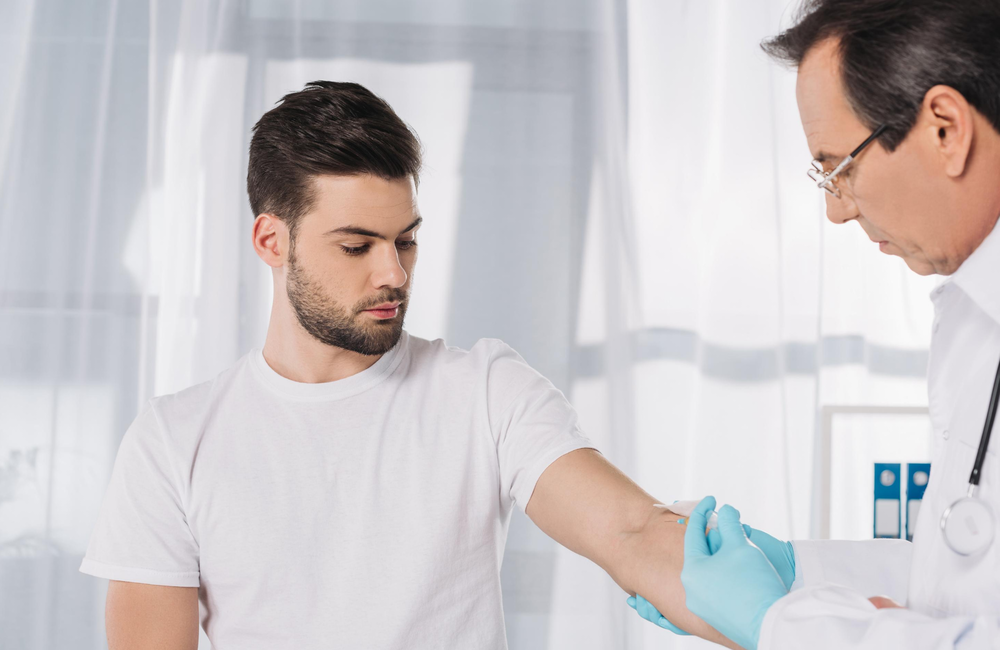
Dutch researchers have found that 79% of sexually transmitted infections (STIs) diagnosed during PrEP users’ routine three-monthly checkups were asymptomatic. They also found that over half (52%) of these infections would have remained undiagnosed, and untreated, for an additional three months if they had only done STI testing every six months.
These two findings encapsulate a dilemma that has faced sexual health clinicians since STI testing became more regular due to PrEP.
The analysis, from Dr Vita Jongen, Professor Maarten Schim van der Loeff and colleagues at the Department of Public Health in Amsterdam is published in Sexually Transmitted Infections.
Background: to test or not to test
STI testing was previously largely conducted only when people had symptoms or during HIV screening appointments which might occur less frequently in people not using PrEP (at present, gay men using sexual health services in the UK test about twice a year on average).
PrEP guidelines recommend testing every three months. More frequent STI testing has uncovered more infections, mainly asymptomatic, that would otherwise have stayed undetected and therefore untreated.
Clinicians feel obliged to treat these, both ethically and in order to reduce onward transmission. Indeed, a modelling study conducted by the same research team found that in theory, frequent-enough treatment of gonorrhoea could lead to a drastic fall in its incidence.
But there are arguments against testing and treating with this frequency. A cost-effectiveness model by the same team found that although screening every three months instead of every six for STIs would avert an extra 18,250 chlamydia and gonorrhoea infections, it would also cost an extra €46.8 million, and the cost per quality-adjusted life year gained would be €430,000, which is not remotely cost-effective (the usual threshold is €20,000).
In addition to the cost, serious complications of chlamydia and gonorrhoea are rare in men, especially of infections that are initially asymptomatic. Though untreated syphilis is a serious illness, six-monthly screening would detect the vast majority of all three STIs before they became serious. Chlamydia and gonorrhoea are often self-limiting infections, succumbing to the body’s own immune response after some months.
In addition, frequent antibiotic treatment could lead to resistance, which is already a serious problem with gonorrhoea.
The study: how many STIs would have gone undetected with six-month screening?
To gain more insight into the data, for the current study the researchers analysed the number and rate of diagnoses of chlamydia, gonorrhoea and syphilis in men who took part in the AMPrEP study, the demonstration project of PrEP in Amsterdam in the Netherlands.
The data were taken from the records of 366 AmPrEP study participants who were recruited between the start of the study in August 2015 and May 2016. They were followed-up till the end of February 2020 (the study continued till December 2020 but its last ten months were affected by COVID).
The study looked at the number of bacterial STIs detected at each three-monthly HIV and STI screening visit. The researchers then calculated a ‘counterfactual’: they calculated how many STIs would have been diagnosed if there had only been screening every six months. They then looked at how many were in fact diagnosed at the intervening three-month visits to find out how many were acquired between four and six months prior to the six-monthly visit – in other words, how many would have been missed and left untreated at the three-month time point.
There were 364 gay and bisexual men and two transgender women in the study, who between them paid 4974 screening visits to the AmPrEP clinic, with an average frequency of exactly once every three months, showing there were very few missed appointments.
Over this time there were 1183 individual STIs diagnosed in 1303 patient-years, an annual incidence of 91 per 100 patient-years.
(This doesn’t mean nine in ten participants caught an STI. It means that in any one year, there were 91 diagnoses of individual STIs for every 100 participants, but that while many caught none, some caught several - as in this comparable Australian study.)
If the detection of more than one STI at a visit was counted as a single ‘event’, there were 855 diagnosis events, 693 of them (81%) featuring no symptoms.
Of the individual infections, 251 were symptomatic, but 932 had no symptoms. This mean that 79% of STIs were asymptomatic and would not have been detected unless tested for.
“I was surprised that the proportion of STIs that were asymptomatic was as high as 79%," Vita Jongen told aidsmap.com. "I’d expected maybe 50%.”
Maarten Schim van der Loeff is concerned that the high rates of STIs seen in PrEP users may be a consequence of their testing more frequently, rather than a real increase. “We do not really know anything about the effects of screening for STIs every three months in men before they start PrEP,” he says, “because most weren’t tested every three months prior to starting it”.
He continues: “It faces us with a question: why are we treating an STI in a client on PrEP? To eliminate symptoms? Or to contain an epidemic?”
In terms of the individual STIs, there were 427 cases of chlamydia diagnosed, of which 355 were asymptomatic (83%); 458 of gonorrhoea, 354 asymptomatic (77%); and 105 of syphilis, 79 asymptomatic (75% - syphilis usually produces visible lesions in its primary and secondary stages but these are easy to miss).
Of the 355 asymptomatic cases of chlamydia, 28 (8%) were of the variant that causes lymphogranuloma venereum (LGV), which isn’t always symptomatic.
If testing had only taken place every six months instead of every three, diagnosis of 52% of these STIs would have been delayed by four to six months; 47% of chlamydia cases, 57% of gonorrhoea cases, and 52% of syphilis cases.
Out of the 364 participants with an STI whose diagnosis would have been delayed if they hadn’t had three-monthly tests, 53% had condomless sex over the next three months and could have transmitted one or more of the undetected asymptomatic STIs during that time.
"Gonorrhoea and chlamydia are known to spontaneously clear in a proportion of cases, so untreated infections are not necessarily permanent."
As well as regular STI screens every three months, AmPrEP also allowed participants to come in for ad-hoc STI testing at any time if they thought they had symptoms, or if they were referred by a contact.
If these 776 extra visits are added in, an extra 139 STIs were diagnosed, to a total of 1322. With the added visits, the proportion of asymptomatic infections becomes lower (because symptoms were the main reason people came in). But asymptomatic infections still form 65% of the total detected and 30% of them would have been missed if the scheduled visits had occurred at six-monthly intervals.
However gonorrhoea and chlamydia are known to spontaneously clear in a proportion of cases, so untreated infections are not necessarily permanent. The only studies of spontaneous clearance cited by the researchers are of people who were not treated immediately, who came in for treatment at a second visit after their diagnosis, and were re-tested then. In the only study that looked at rectal infections, the average gap between initial and second tests was only ten days; even so during this time, 12.7% of cases of rectal chlamydia and 20% of cases of rectal gonorrhoea in men spontaneously cleared, without the need for treatment. Clearance rates were higher for women and for pharyngeal (throat) infections.
"I am convinced”, Maarten says, “That most asymptomatic cases of chlamydia and gonorrhoea do go away by themselves in the end. But it would be very difficult to test this, as it’s impossible to distinguish between the original infections and new ones over a longer timescale.”
In the case of syphilis, if primary and early secondary infections are missed, a six-monthly test should be sufficient to detect the infection before any progression to complicated illness. Also, syphilis is detected via a much less expensive blood test which can easily be integrated with three-monthly HIV tests.
Can we predict who might need more frequent testing?
The Australian study cited above found that its much larger cohort was split into higher-risk and lower-risk groups with very different probabilities of acquiring an STI. In that study, 55% of the PrEP users never caught an STI during their study, but of those who did, the average number of STIs was three.
In the AmPrEP demonstration project, there were some participant characteristics associated with higher STI risk. Participants were also asked to keep sex diaries and report on encounters and, perhaps not surprisingly, condomless sex with named casual and anonymous casual partners increased the likelihood of an STI by 36% and 86% respectively; chemsex (practised by 43% of participants) increased its likelihood by 51%.
Conversely, STIs were less common in the 27% of participants who chose to take event-driven rather than daily PrEP, probably because they had less sex that risked HIV or STIs. Older participants had fewer infections, with a 14% decrease in STI infections per ten-year increase in age.
It was hoped these could be turned into ‘risk scores’ that could then be used to decide which participants needed to be tested for STIs every three months and which could wait for six months. However these risk scores only had a sensitivity of 70%, meaning they’d miss 30% of high-risk people (false negatives); and a specificity of only 50%, meaning they’d wrongly identify half of lower-risk people as high-risk (false positives).
Vita comments: “The people coming forward for the PrEP demonstration project were likely to be in the higher-risk group. I still think if we repeated this research on a larger group, maybe in a couple of years’ time when PrEP use becomes more general in the Netherlands, we will find more lower-risk people have started using it who do not need such frequent STI tests.”
The other problematic issue with frequent STI treatment is that people end up frequently taking antibiotics. One well-known consequence of this is the possibilities of organisms developing resistance, especially the gonorrhoea bacterium.
Maarten comments: “Adherence is not an issue, because the usual treatment for gonorrhoea is an injection of ceftriaxone. However, although it has not progressed to drug resistance, we have noticed a slow decrease in susceptibility to ceftriaxone in gonorrhoea.”
Both researchers expressed scepticism about STI prophylaxis, which surveys have not found to be common in the Netherlands, and may be less effective against gonorrhoea. A meningitis B vaccine is of marginal efficacy against gonorrhoea and results so far have not been impressive.
(It is worth mentioning however that a US study, in Seattle and San Francisco, of post-exposure STI prophylaxis, was stopped recently owing to str0ng evidence of efficacy. Full results will be announced at the forthcoming world AIDS Conference in Montreal.)
At the moment however this research would indicate that testing for STIs and treating them every three months in PrEP users is not something clinics should abandon.
However more research into spontaneous clearance, STI rates in lower-risk PrEP users, and the degree to which treating all diagnosed cases does have population-level effectiveness, is clearly necessary if we are not to waste antibiotics and treat unnecessarily.
Jongen VW et al. Can we screen less frequently for STI among PrEP users? Assessing the effect of biannual STI screening on timing of diagnosis and transmission risk in the AMPrEP Study. Sexually Transmitted Infections, online ahead of print, 18 May 2022 (open access).

